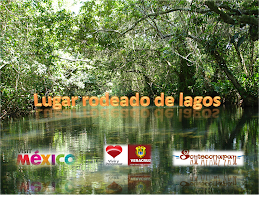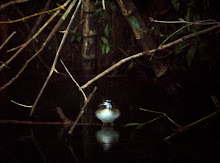
La Barra
Con una población de 318 ha, situada en el final de un camino de terracería que separa al Golfo de México de la Laguna de Sontecomapan. La mayor parte del área costera consiste en dunas de arena ambientalmente amenazadas y tortugas marinas que periódicamente tienden a ser pisoteadas por el ganado que pasta por los alrededores, y milagrosamente han sobrevivido.
The BarraWith a population of 318, located at the end of a road of terracería that separates the Gulf of Mexico of the lagoon of Sontecomapan. Most of the coastal area is environmentally threatened sand dunes and sea turtles that periodically tnd to be scornd by livestock grazning in the vicinity and have miraculously survived.
La pequeña comunidad vive de la pesca y el abastecimiento a los turistas locales y nacionales. La mayor parte del año sus playas y restaurantes están solitarios y los kilómetros de orilla son paraísos para pasear. Las numerosas palapas que tocan la arena en la entrada del Golfo hacen señas a los visitantes con abundantes mariscos frescos.
The small community living fishing and supply tourists local and national. The most of the year is its beaches and restaurants are solitary and the kilometres of shore are havens to walk. The numerous palapas that touch the sand at the entrance of the Gulf make signs to visitors with abundant fresh seafood.

Una manera de gozar este “refugio” es ir en el taxi acuático de Sontecomapan a La Barra, punteando cerca de 8 kilómetros del camino feo que puede convertirse en pavimento en el 2015.
One way to enjoy this refuge is going by water taxi from Sontecomapan to the bar, punteando near of 8 kilometres of the ugly way that can become pavement by 2015.

La Laguna Es una gran laguna costera formada por la desembocadura, en el Golfo de México, de los ríos que bajan de la sierra. La unión del agua dulce (ríos) y salada (de mar) ha creado el ambiente adecuado para que abunde la laguna, árbol de enormes raíces que se observa durante el paseo en lancha, a la vez que se miran numerosas aves acuáticas, cangrejos y otros animales.The Laguna
The lagoon is a large coastal lagoon formed by the mouth, in the Gulf of Mexico, the rivers that lower of the sierra. The Union of freshwater (rivers) and salt (sea) has created the appropriate environment for abunde the lagoon, huge roots seen during the boat, ride to look many waterfowl, crabs and other animals tree.

Uno de los atractivos es la instalación a la orilla de la laguna en un campamento cerca de un manantial de agua mineral. Convivencia de integración del turista con la naturaleza y otras personas en una fogata organizada en el campamento.One of the attractions is the installation to the edge of the lagoon in a camp near a spring mineral water. Coexistence of integration of the tourist with nature and others in a campfire organized in the camp.
El recorrido es en lancha de remos por un canal angosto y cerrado lleno de lianas y plantas, un túnel vegetal que desenboca en la laguna. Entonces se transborda en una lancha de motor de alta velocidad donde se pueden ver aves como águilas pescadoras cormoranes, gaviotas y pelícanos. The tour is oars by a narrow and closed channel full lianas and plants, boat plant tunnel to desenboca in the lagoon. Then transborda in a boat engine high-speed birds such as pescadoras Eagles can where you see cormorants, seagulls and pelicans.
 El Manglar
El Manglar
Forma parte del patrimonio natural de México y del mundo.
Actualmente se encuentra inscrito en la lista Ramsar con el número 1342. Su importancia se reconoce en términos biológicos, culturales y económicos. Su valor biológico está fundamentado en el papel que este ecosistema representa para numerosas especies animales y vegetales, al funcionar como hábitat, refugio y zona de anidación y desolve. Una característica distintiva de este manglar son las dimensiones estructurales que presentan sus especies arbóreas así como la presencia de otras plantas asociadas a este ecosistema, principalmente epífitas y orquídeas, muchas de ellas amenazadas con la extinción.
The Mangroves
Part of the heritage of Mexico and the world. Is currently registered in the Ramsar list with number 1342. Its importance is recognized in biological, cultural and economic terms. Its biological value is based on the role of this ecosystem represents for many animal and plant species to operate as Habitat, shelter and nesting and desolve area. A distinguishing feature of this mangrove are structural dimensions showing their species as well as the presence of other plants associated with this ecosystem, mainly epiphytes and orchids, many of them threatened with extinction.
many of them threatened with extinction.
Actualmente su valor cultural está subestimado, aunque la zona del manglar de Sontecomapan tuvo relevancia desde la época prehispánica con la cultura Olmeca. A nivel económico, este manglar es fuente de alimentación e ingresos para numerosas familias.
Its cultural value currently downplayed, although the area of Sontecomapan manglar had relevance from pre-Hispanic times with the Olmeca culture. Economically, this manglar is source of food and income for families.
 conservation, live with local cultures and practise sustainable tourism that lets you combine rest and live a unique experience. Is an activity that reflects the trend of travel in the world change.
conservation, live with local cultures and practise sustainable tourism that lets you combine rest and live a unique experience. Is an activity that reflects the trend of travel in the world change.














